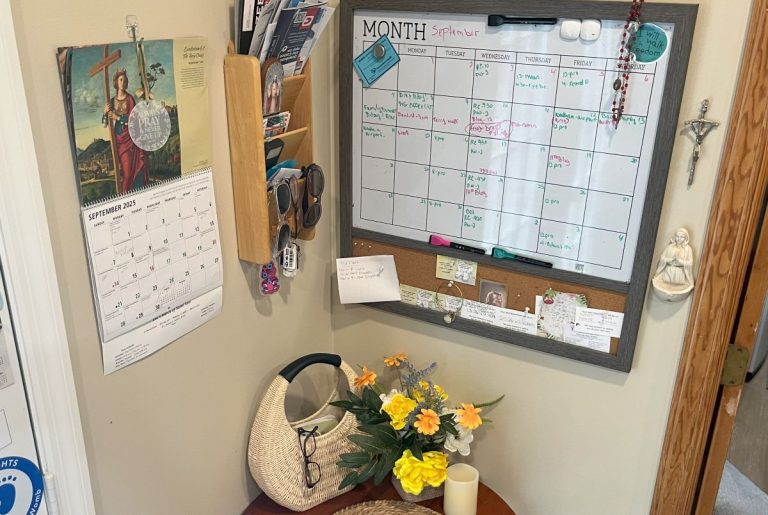Do the Math! What Does It Really Cost to Work? (pt 2)
Step 1 in “How to be a Stay at Home Mom, Financially”
If you’ve been wondering how to financially be a stay-at-home mom, you’re not alone. The idea of dropping to one income can feel impossible! By doing some math, you might find that working costs more than you think. In this post, we’ll take a practical and prayerful look at what it truly costs to work outside the home, and how staying home might be more financially—and spiritually—doable than it seems.
The $2 Realization-Your Time Is Worth More Than You Think
I had just stopped at our favorite pizza place on the way home from work. I was proud of myself for remembering the pizzeria was on my route home and for calling in the order ahead of time. I was glad not to have to go home and cook dinner after a long day. I had recently taken on my first job in 28 years, since becoming a stay-at-home mom, and honestly — I was exhausted.
But as I thought about the pizza and the satisfaction of having earned the money for it, I started doing the math in my head.
After taxes, gas, and time… I had maybe $2 left from that entire day.
I had traded eight hours of work (plus a commute) just to pay for a few pizzas.
And that’s when it hit me:
Was it really worth it?
I put in my notice the next day. Surely there were better ways for me to spend my time. How much is your time worth to you and your family?
The Hidden Expenses of a Two-Income Household
When most people think about income, they don’t subtract the hidden costs of working. Childcare and commuting are obvious, but there are so many others we don’t always consider.
What if you didn’t need:
- A cleaning lady
- Lawn service
- Fast food or takeout
- Professional clothes
- Daily coffee runs
- Expensive convenience groceries
- Constant car maintenance
And instead, you had the time to:
- Cook more meals
- Shop smarter
- Use less gas
- Be home when your child is sick
- Simplify your life
Let’s break it down. Grab a notebook and get honest! Here are some blanks to fill in for your own budget:
Sample “Cost of Working” Budget Worksheet
- Monthly Take-Home Pay: $______
- – Childcare: $______
- – Commuting (gas, tolls, parking): $______
- – Work Wardrobe: $______
- – Convenience Meals / Fast Food: $______
- – Coffee / Snacks: $______
- – Car Maintenance / Wear & Tear: $______
- – Dry Cleaning / Other Work-Related Costs: $______
- – House Help (cleaning, yard work, etc.): $______
= Net Income After Expenses: $______
If your take-home pay shrinks significantly or even goes negative-it may be a sign that staying home is more financially doable than you thought.
Hidden Financial Gains of a Stay at Home Mom
Looking back, my husband and I realize that my being home gave our family more value than we understood at the time. It didn’t just save money — it created freedom.
When one parent is home, the other can focus more fully at work, opening up promotion and advancement opportunities. My husband never had to worry who would care for the kids when they were sick or who would be at their events. And when promotions required us to relocate, we were free to say yes because I wasn’t tied to another job.
Within just a few years of our decision for me to stay home, his income doubled making up for the loss of my income. That growth wouldn’t have been possible if we were both working full-time and juggling responsibilities. Staying home may have looked like a loss on paper, but in reality, it was an investment that paid off.
Opportunity Costs: What Are You Trading for a Paycheck?
Beyond dollars, the biggest cost of working is often time with your children.
Even with a trusted relative helping, life happens. People get tired, health declines, plans change. My mom used to say, “Raising kids is for the young.” It’s hard, all-day work that takes energy, patience, and presence.
If you’re gone 8–10 hours a day, five days a week, someone else is spending more of your child’s waking hours than you are. You’re missing those fleeting everyday moments — the ones that may not go in a baby book, but live in your heart forever.
I don’t share this to guilt you but to give you permission to value your time as a mother. It’s okay to measure your worth in something other than a paycheck.
Encouragement as You Calculate
Doing the math might feel uncomfortable at first but it’s freeing. When you see the full picture, you can make a confident, prayerful decision.
You don’t have to have it all figured out.
You just need to take the next step and trust that God will meet you there.
In my next post, I’ll share the practical ways we learned to be better stewards of our finances and how we creatively made staying home possible.
If you haven’t read Part 1 of How to Financially be a Stay at Home Mom- click here to get caught up!
Up Next is finding new ways to cut and get creative with finances in order to be better stewards with our resources.
Be sure to sign up for my email list, not only will you get my e-book of 15 simple morning prayers, but you will also be the first to see my future posts!








EXCELLENT article, again, Margaret!!! I am sharing it with a few younger moms that I know❤️❤️❤️❤️.
Thank you Sharon!